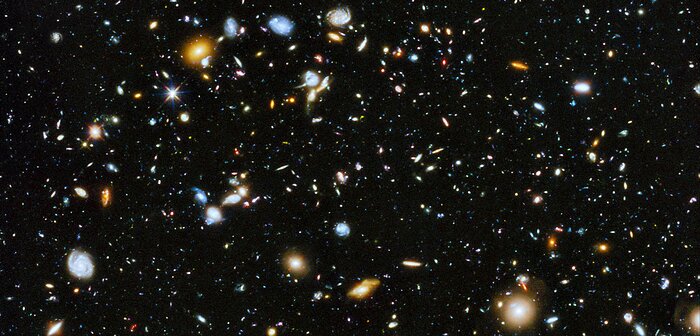An excerpt of the Hubble Deep Field
The Universe is crammed with galaxies, as illustrated by the Hubble Ultra-Deep Field (pictured), but if it’s brighter than expected, then there could be even more galactic structures than previously thought.
Credit:NASA, ESA, H. Teplitz and M. Rafelski (IPAC/Caltech), A. Koekemoer (STScI), R. Windhorst (Arizona State University), and Z. Levay (STScI)
About the Image
| Id: | STScI-gallery-1427a-2000x960 |
| Type: | Simulation |
| Release date: | March 23, 2021, 11:49 p.m. |
| Size: | 2000 x 960 px |
About the Object
| Constellation: | Fornax |
| Category: | Galaxies |
Wallpapers
Coordinates
| Position (RA): | 3 32 37.18 |
| Position (Dec): | -27° 46' 45.71" |
| Field of view: | 2.30 x 1.11 arcminutes |
| Orientation: | North is 52.0° left of vertical |
Colors & filters
| Band | Wave-length | Tele-scope |
|---|---|---|
| Ultraviolet UV | 275 nm | Hubble Space Telescope WFC3 |
| Optical V | 606 nm | Hubble Space Telescope ACS |
| Optical B | 435 nm | Hubble Space Telescope ACS |
| Optical U | 336 nm | Hubble Space Telescope WFC3 |
| Ultraviolet UV | 225 nm | Hubble Space Telescope WFC3 |
| Optical Long Pass | 150 nm | Hubble Space Telescope ACS |
| Optical I | 775 nm | Hubble Space Telescope ACS |
| Infrared Y | 1.05 μm | Hubble Space Telescope WFC3 |
| Optical Long Pass | 850 nm | Hubble Space Telescope ACS |
| Optical I | 814 nm | Hubble Space Telescope ACS |
| Infrared H | 1.6 μm | Hubble Space Telescope WFC3 |
| Infrared J | 1.25 μm | Hubble Space Telescope WFC3 |
| Infrared J/H | 1.4 μm | Hubble Space Telescope WFC3 |

